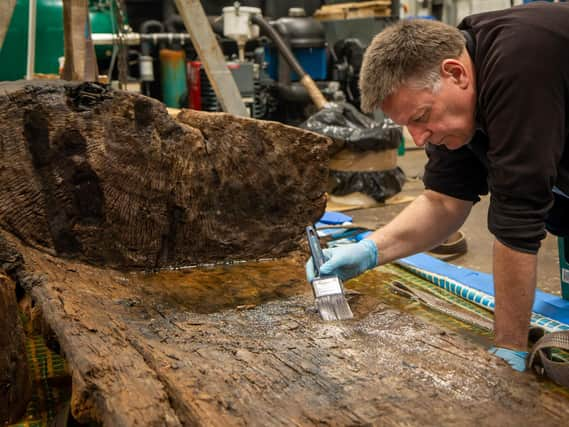Bronze Age log coffin containing remains of man buried with axe discovered by accident on golf course near Grimsby


The coffin was found by chance during work to a pond at Tetney Golf Club and sparked a rescue mission from the University of Sheffield’s Department of Archaeology.
A £70,000 grant from Historic England helped support the rescue of the coffin, which was specially protected to ensure the delicate structure did not crumble after it was exposed to the sun and air.
Advertisement
Hide AdAdvertisement
Hide AdThe find was made by chance in July 2018, during a spell of hot weather.
The golf club’s owner, Mark Casswell, was put in contact with the Portable Antiquities Scheme and Historic England.
Following a year of cold storage while being assessed, it was moved to York Archaeological Trust where it has been undergoing preservation work. The work will soon be completed, and the items moved to The Collection Museum in Lincoln.
According to the archaeologists, the axe seems more a symbol of authority than a practical tool, while the coffin gives an insight into how social hierarchy was marked out in the early Bronze Age.
Advertisement
Hide AdAdvertisement
Hide AdSo far, yew or juniper leaves have been found within the coffin and further work is planned to discover more about how plants were used in this burial practice, and the time of year the burial took place.
The axe is extremely rare, and there is thought to be only 12 known from Britain, especially because the wooden shaft survives as well as the stone head.
The coffin itself was created by carving a single fast growing oak tree.
Dr Hugh Willmot of the University of Sheffield said: “Luckily when the burial was found, myself and a team of staff and students from the Department of Archaeology at the University of Sheffield were working on a nearby research and training excavation.
Advertisement
Hide AdAdvertisement
Hide Ad“This was a brilliant learning experience for our students to see what can be achieved at short notice and I’m so pleased we were able to help.”
Mark Casswell, owner of Tetney Golf Club, said: “My family farmed here for years before we opened the Golf Course and I’d never have imagined that there was a whole other world buried under the fields.”